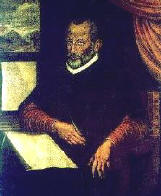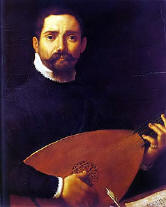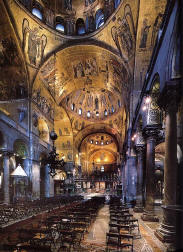Renaissance Composers:
|
Giovanni Pierluigi da Palestrina (1525-1594) has sometimes been called the 'savior of church music'.
In 1548 Edward VI decreed that music in the Church of England must be sung in English "settyng therunto a playn and distincte note, for every sillable one". In other words, no more polyphony. In 1555, the Catholic Pope decided that the secular spirit of some music, the noisy instruments in the church, and the complicated polyphony that made it impossible to understand the words was bad and wanted to return to the simplicity of music like Gregorian Chant. He created the "Council of Trent', asking church leaders to formulate measures to purge the Church from 'abuses and laxities'. It looked like the music of the times was going to get very boring!
But Palestrina composed a six-voice Mass (Mass of Pope Marcellus ) to demonstrate that the polyphonic style did not necessarily interfere with the understanding of text. This composition convinced the Council of Trent of the value of polyphonic music and secured it's place in the music of the Church.
Palestrina took his name from the town near Rome where he was born. He served as a choir boy and in 1544 was appointed organist and choir master in Palestrina, Italy. In 1554, he dedicated to Julius III (1549-55) his first compositions, a volume of masses for four voices, and was rewarded with the appointment as a member of the papal chapel choir, even though he didn't sing very well at all. He taught music from 1565-1571 and then returned to St. Peter's , where he remained as choirmaster until his death. The decade of the 1570s was difficult for him personally; he lost his brother, both his sons, and his wife in three separate outbreaks of the plague (1572, 1575 and 1580 respectively). He seems to have considered becoming a priest at this time, but instead he married again, this time to a wealthy widow; this finally gave him financial independence (he was not well paid as choirmaster) and he was able to compose prolifically until his death.
He wrote 102 Masses, 450 Motets and several other sacred songs. He also composed 83 secular songs, but later in life he 'blushed and grieved' to have written music for 'profane love songs'.
|

|
On YouTube | Click here for closed captioned video transcript of video
Palestrina has been called the "Prince of Music", and is probably the most famous composer before Bach. He captured the cool, sober purity of sound the Council of Trent was looking for. His voice parts flow in continuous rhythm, melodic motives passed from one voice to the next , leaving the listener awash in their beauty. Most of his Masses are built on themes from Gregorian Chant melodies. Palestrina's style was the first in the history of Western music to be consciously preserved and imitated by other composers.
 Palestrina - Kyrie from Pope Marcellus Mass
Palestrina - Kyrie from Pope Marcellus Mass
 Palestrina - Pueri Hebraeorum
Palestrina - Pueri Hebraeorum
|

|
Gabrieli
Giovanni Gabrieli (c. 1554/1557 – 1612) was an Italian composer and organist. He was one of the most influential musicians of his time, and represents the culmination of the style of the Venetian School, at the time of the shift from Renaissance to Baroque eras. Giovanni was probably born in Venice, Italy. He was one of 5 children, and was probably raised by his uncle, Andrea Gabrieli, a noted composer of this time. By 1584 he became the organist at Saint Mark's Basilica in Venice, and after his uncle died, Giovanni became the chapel composer as well. Saint Mark's had a long tradition of musical excellence - the best Italian singers and instrumentalists would come to perform here, so Gabrieli became famous throughout Italy and the rest of Europe. Many composers came to learn from him.
|
On YouTube | Click here for closed captioned video | transcript of video
 |
Like composers before and after him, he would use the unusual layout of St. Mark's, with its two choir lofts facing each other, to create striking spatial effects. Most of his pieces are written so that a choir or instrumental group will first be heard from the left, followed by a response from the musicians to the right. This style of 'dueling' music is known as antiphonal music. Gabrieli pioneered the use of carefully specified groups of instruments and singers, with precise directions for instrumentation, and in more than two groups. He wrote choral pieces for as many as 5 different choirs, each composed of different combinations of high and low voices, as well as instruments and soloists. The acoustics were such in the church (and they have changed little in four hundred years) that instruments, correctly positioned, could be heard with perfect clarity at distant points. Thus instrumentation which looks strange on paper, for instance a single string player set against a large group of brass instruments, can be made to sound, in San Marco, in perfect balance. |
Below is an example of his work - Plaudite. It is written for 3 separate choirs (12 parts) and antiphonal brass choirs as well. Try to imagine sitting in a large church (the picture to the left is St. Marks) with this music coming from all sides, bouncing and reverberating off the walls.
 Gabrieli - Plaudite
Gabrieli - Plaudite
Gabrieli was the first composer to designate particular instruments for each part. Before, any instrument that could play the notes written could be used. Gabrieli was composing with a particular sound in mind. He was also the first to indicate dynamics in a piece of music - how loud or soft each section of the music should be.
 Gabrieli -Canzon septimi toni a 8
Gabrieli -Canzon septimi toni a 8
Other Composers
Josquin des Prez (Flemish)
Josquin (1450? - 1521) is known as one of the greatest composer of the age. He was the first master of the high Renaissance style of polyphonic vocal music that was emerging during his lifetime.
On YouTube | Click here for closed captioned video | Click here if video above is blocked | transcript of video
Orlando di Lasso
di Lasso (also known as di Lassus, 1532-1594) wrote over 2000 musical pieces during his lifetime.
 di Lasso - Jubilate Deo
di Lasso - Jubilate Deo
Byrd (English)
William Byrd (1543 - 1623) was the leading English composer of his time , and perhaps of all times.
 William Byrd - Ave Verum Corpus
William Byrd - Ave Verum Corpus
Morley (English)
Thomas Morley (1557 or 1558 – early October 1602) was famous for his English Madrigals - unaccompanied secular songs for 3 to 6 voice parts
 Morely -Sing_We_And_Chant_It
Morely -Sing_We_And_Chant_It
Monteverdi (Italian)
Claudio Monteverdi (1567-1643) is most noted for his Italian madrigals. He wrote one of the first operas and his music marked the transition from the Renaissance to the Baroque.
 Monteverdi - O Chiehi, O Chiehi
Monteverdi - O Chiehi, O Chiehi
|
Assignment # 2 Name that Tune
Take a quiz to see if you can identify music presented in this Unit.
Music in the quiz will come from this list:
|


